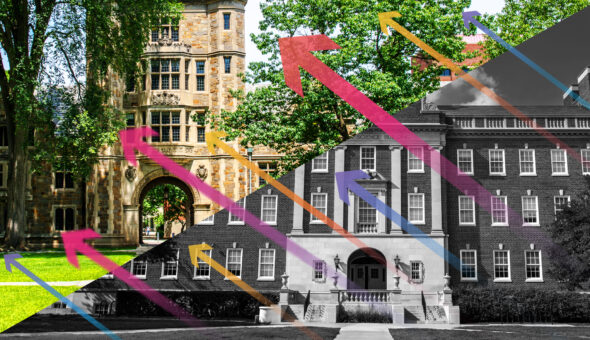In March 2020, I packed my essential work items, took a photo with my coworker as we exited the building, and confidently declared we would return together in a month. Similar scenarios unfolded at universities nationwide with many embracing a temporary shift to remote work until COVID-19 was in the rearview. As months passed, it became clear that the workplace culture we once knew was gone. Although this period ushered in more innovation and a forward-thinking vision for the future, it was marked by uncertainty as everyone grappled with the impact of these changes on their roles and the institutions’ identities.
Amid this upheaval, university marketing and communications teams devised a strategy that disseminated crucial information about new procedures and helped foster a sense of unity. Teams bridged the gap between the administration and the campus community through targeted messaging that reinforced a university’s founding principles and values, expressed care for the community by exchanging standard practices for safer ones and promoted two-way communication. This strategy helped to reduce apprehension and elevate collective commitment to an institution’s evolving mission. Similar scenarios happened at campuses across the country, and it is within these stories of transformation and unity that we find the unsung hero, the driving force behind a cohesive and thriving academic community — internal communications.
Internal communication is often lumped in with employee communication, primarily a human resources department function. Usually limited to announcing changes in benefits, event announcements and emails from departments and executives, internal communications are essential to advancing a university’s external brand identity. An effective internal communications strategy can help align an institution’s values and mission with the cultural landscape of higher education, ensuring that all stakeholders share a common vision even during times of uncertainty.
1. Establishing a Culture
Although the higher ed cultural landscape is ever-evolving, there are constants, such as the mission to impart knowledge and educate students. Colleges and universities have traditions, values and pledges that are reinstituted annually during orientation season; however, these are rarely shared with faculty and staff during onboarding, meaning alumni employees are often higher-performing employees. Graduates know the school best and have passion for their work and a strong sense of belonging and purpose in their roles.
Higher education institutions that desire to thrive in this global society and want their employees to succeed should have well-defined mission and values statements that live and breathe throughout campus. These statements drive institutional success and motivate employees. A workforce doesn’t move forward because the leadership says so; it moves forward because the employees know why they are moving in the first place. Unlike some university traditions, missions and values cannot be static; they must advance as new generations of students and industry leaders emerge.
2. Motivating a Workforce
I’ve been told that it takes a generation to change a culture, but new leadership can have an effect. For example, the chancellor of my prior institution was very family-oriented. The affinity between him and his wife was so apparent that their closeness became infused into the campus culture, so much so that being a family became one of the school’s strategic priorities.
Although cliche, family is a concept that everyone can appreciate, even across generations. The workplace is an environment where cultures intermingle. In her article “Generations are Cultures Too,” Jamie B. Gelbtuch noted work teams can have as many as four generations working together.
“This means four generalized sets of expectations, motivations, attitudes, behaviors, and communication styles […] leading to four different sets of perceptions and often misperceptions,” said Gelbtuch.
However, different generations can agree upon certain things, such as respect, purpose and a sense of belonging. Cultural experiences play a role in how these things are interpreted and what motivates multi-generational employees. In her book, “The Insider’s Guide to Culture Change: Creating a Workplace that Delivers, Grows, and Adapts,” Siobhan McHale wrote that workplace culture is “the patterns or agreements that determine how the business operates.” According to McHale, employees construct and give meaning to occurrences and statements in the workplace. Every memo and every recognition, or lack thereof, carries meaning for employees.
As a leader, I’ve grappled with the challenge of publicly acknowledging employees for their contributions, hesitating to give random commendations out of concern for inadvertently overlooking someone equally deserving. I have been on teams where the prevalent sentiment is that such recognition practices could foster toxicity within the workplace.
At my previous institution, I led the implementation of an annual awards recognition program, a unique initiative resembling the People’s Choice Awards, during which peers made nominations and selections. Distinctive categories, such as the “Night Light Award” for those known for putting in extra hours and the “Maestro/a Award” for exceptional leadership among team members, provided a platform for acknowledging outstanding contributions. Notably, the leadership team was excluded from the nomination and selection process. Trophies were given and often displayed proudly in awardees’ offices.
This peer-driven approach proved rewarding, allowing colleagues to recognize each other’s efforts and shedding light on employee contributions beyond mere productivity and numerical achievements. Intentionally excluding leadership from the process mitigated the risk of excessive commendations and awards, ensuring genuine excellence stood out. While it may seem stringent, this approach motivates employees and teams by presenting recognition as something to be earned rather than commonplace, fostering a sense of accomplishment and aspiration.
3. Supporting Employee Retention
Workplace culture is more important than ever. Remote work and isolation during the pandemic allowed employees to reflect on what’s meaningful. As workplaces evolve and cultural dynamics transform, it becomes increasingly evident that some higher education institutions contend with deeply ingrained traditions that resist change.
Some institutions have traditions that date back hundreds of years — practices that hinder progress and contradict the inclusiveness and sense of belonging that most universities now tout. These practices and behaviors often marginalize some groups and people while advancing others. This can be incredibly challenging for predominantly white institutions, many of which were founded before our nation realized civil rights and equity.
The persistent nature of these practices creates a barrier for employees from diverse backgrounds, impeding their ability to thrive within such environments. For this reason, Hale noted that core values statements alone don’t bring about meaningful change. These practices must be exposed and eliminated to have values and mission statements that dictate culture. This process is crucial for fostering inclusiveness, dismantling systemic biases and aligning institutional values with the evolving needs of a diverse and dynamic higher education workforce.
Some of these practices are so deeply infused into an institution that even those most affected don’t recognize it. In the work environment, especially when we’re new to a team, we are often told, “This is how we’ve always done it.” If the pandemic and remote work have taught us anything, we can no longer approach internal communications the way we did pre-pandemic. Now, it takes more out-of-the-box thinking and an inclusive mindset.
4. Advancing Brand Promise
As a higher ed communications and marketing professional, I have embraced a personal philosophy based on my professional experience: “Every employee is responsible for the brand.” The internal stakeholders are pivotal in elevating the university’s brand promise, from the institution’s president to facilities management and the faculty, as well as the residence hall directors and support teams. They are frontline ambassadors. Prospective students are more likely to make first contact with a staff member before they meet faculty members.
My first position in higher education was as a temporary support associate in facilities management, the department responsible for the university’s sustainability of buildings, environmental safety, grounds and infrastructure. During my tenure at that university, I served in departments within academic affairs and later the chancellor’s office. Although I wasn’t an alum, I knew the university from the foundation to the top. That experience taught me that any employee can become a brand ambassador and advocate for a university once they are immersed in the culture and understand what makes the university distinct.
Every internal email communication should reflect the institution’s brand, mission and values. The mission and values lived and breathed by employees directly affect the institution’s brand promise. My graduate school alma mater promises that every student will receive an “extraordinary education in an inspiring environment with caring people.” That’s a brand promise that they have guaranteed. Their promise is presented to an external audience: prospective students and their parents. However, without buy-in from the faculty and staff, this promise would fall short because these people are the couriers of that promise.
Internal communications are invaluable to the success of any organization, especially now that many in-person jobs are hybrid or remote. According to Ronnie Gomez, content strategist for SproutSocial, internal communications should be given the same level of strategic planning and prioritization as advancement communications, student recruitment and curriculum development. A university’s mission and values must be updated to eliminate systematic biases and to match the cultural landscape. These should be continuously communicated to and embraced by employees. Strong internal communication practices can assist with building a work culture where everyone feels respected and operations are effective and productive. Leadership must show employees that their contributions advance the institution. That knowledge alone can motivate and create a work culture where everyone feels a sense of belonging.







